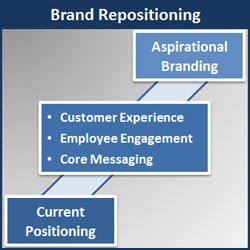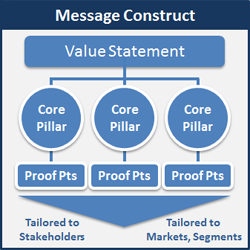
Recently, we were asked by a long-term client to help them reposition their brand in the marketplace. 2014 is a milestone year for the firm as they introduce significant process innovations that will help redefine the way they—and the industry—do business.
Leveraging this milestone with an eye to the future, rather than a look back, provided them a great platform for reinvigorating their brand messaging to better reflect who they are and effectively position them for decades to come.
Over the years, we’ve found that the concept of branding is still somewhat misunderstood. To some, branding is synonymous with designing a new logo or crafting a clever tag line. While those can be important elements of a rebranding, we believe strong messaging lies at the heart of effort and drives the look and feel.
Another branding reality is that your reputation is built 80% on experience and 20% messaging. Organizations must be able to deliver on their brand promise—and engaged employees are those most critical to making that happen. Make sure your message is framed in the context of how it supports the customer experience.
The Brand Repositioning Process
At its core, brand repositioning is about getting a bead on where you are today versus where you want to be—then crafting the messaging first and the look second, to help you get there. When implementing a branding messaging program for our clients, we employ a three-step process outlined below.
Discovery
As the name implies, you start with a solid understanding how your brand is currently perceived by your key stakeholders—customers, employees, shareholders, and industry influencers, for example. In the case of our client, they had a long-standing reputation in the market—a strong foundation on which to build. Look at how you’re currently presenting yourself to those audiences. And, the tougher half of the equation—based on the firm’s vision and strategic plan; articulate what you want the brand to stand for going forward.
An important step in Discovery is to audit your current messaging, by reviewing a wide range of marketing, sales support and communications materials. Your review should include proposals, collateral, articles, digital and social content.
Use the findings of that audit, along with feedback from your stakeholders, to help coalesce the leadership team around the more aspirational brand messaging. What messages still resonate with your targets and represent who you want to be? Conversely, what is overused and no longer a differentiator, has become stale and should be eliminated from your corporate lexicon?
Be sure to get a good cross-section of perspectives—from different functional areas and levels of your organization. Once insights are gathered, common themes begin to emerge and will help guide your message development. Finally, conduct a competitive scan to understand the environment in which you’re positioning must stand out.
Design
In the design phase, you map out the messaging, and set the tone and voice for your new positioning. When building the message blueprint, it is important to capture the firm’s story in a way that not only resonates across key stakeholder groups but is easily tailored to the various audiences and market segments that are important to your business.
The message construct starts with a value proposition—one to two sentences that align your strengths with relevant, high priority client needs and distinguishes you from the competition. Typically, this is one of the toughest parts of the process.
From that base come three-to-five core messages that succinctly spell out what you offer in the marketplace, details where you excel, and how this benefits customers.
Proof points pay off each core message, giving your targets a reason to believe. Any audience or market specific messaging is spelled out here. The result is a common blueprint for brand positioning that will guide development of all your materials.DeliveryIn delivery, it’s all about execution. This is where the new messaging synchs up with the look and feel to roll out your new positioning. Your website is one of the more impactful stops throughout a buyers’ decision journey and as such, is often #1 in terms of delivery priority. Ensuring Success Ensuring Success
When embarking on a brand positioning, it is important to keep the end game in mind. In order to be effective, brand messaging must be:
Great positioning can do a lot for a brand in keeping it relevant and distinct in the marketplace. It not only supports the growth of the business, but also can re-energize the internal team. Done right, it should serve you well in the immediate term as well as years down the road. Think about your brand today. Does it reflect who you are and who you want to be? |

